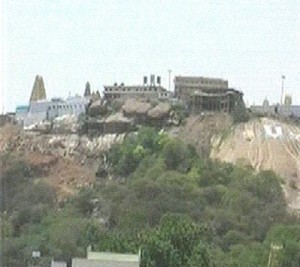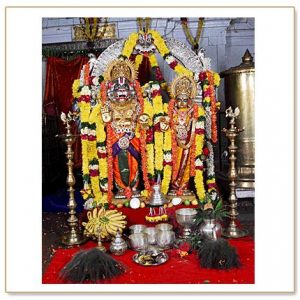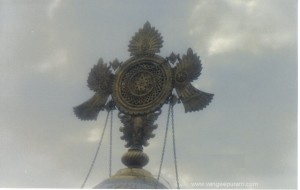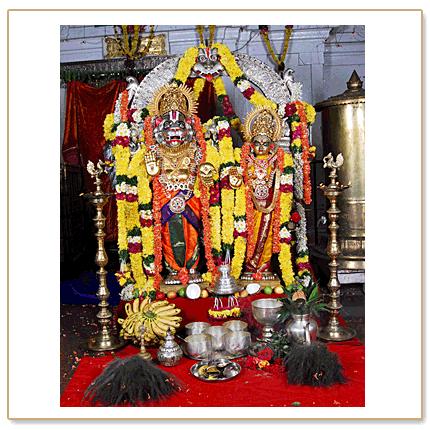Sri Lakshminarasimha Swamy Temple at Yadagirigutta is a popular temple of Narasimha Swamy which is situated on a hillock in the Nalgonda district, Andhra Pradesh, 60 kilometers from the city of Hyderabad.
LEGEND:
In Tretayugam, there lived a sage by the name of Yadarishi, son of the great sage Rishyasrunga and Santa Devi who did penance inside a cave with the blessings of Anjaneya on this hill between Bhongir (Bhuvanagiri) and Raigiri (Now in Nalgonda district of Andhra Pradesh, India). Pleased with his deep devotion, Lord Narasimha, an incarnation of Lord Vishnu appeared before him in five different forms as Jwala, Yogananda, Gandabherunda, Ugra and Lakshminarasimha. They later manifested themselves into finely sculpted forms that later came to be worshiped as Pancha Narasimha Kshetram.
 As the legend goes, the Lord appeared first as Jwala Narasimha (Lord as a flame), when Yadarishi was unable to face the intensity of this apparition, he appeared in a peaceful form as Yoganarasimha (Lord in a Yogic Padmasana posture with open palms on the knees). Not satisfied with the Lord appearing alone, Yadarishi sought to see him with this consort, so Lord is said to have appeared with Lakshmi on his lap, known as Lakshmi Narasimha Swamy. To see these three forms one has to go through an entrance that narrows itself into a dark cave. Interestingly, the cave is formed under a huge rock, which forms a sloping roof into a height of just 5-ft in the middle for the passage inside. While going through this constricted passage one has to necessarily lower the head slightly. Thus the very natural formation of the cave itself makes one bow involuntarily to the Lord.
As the legend goes, the Lord appeared first as Jwala Narasimha (Lord as a flame), when Yadarishi was unable to face the intensity of this apparition, he appeared in a peaceful form as Yoganarasimha (Lord in a Yogic Padmasana posture with open palms on the knees). Not satisfied with the Lord appearing alone, Yadarishi sought to see him with this consort, so Lord is said to have appeared with Lakshmi on his lap, known as Lakshmi Narasimha Swamy. To see these three forms one has to go through an entrance that narrows itself into a dark cave. Interestingly, the cave is formed under a huge rock, which forms a sloping roof into a height of just 5-ft in the middle for the passage inside. While going through this constricted passage one has to necessarily lower the head slightly. Thus the very natural formation of the cave itself makes one bow involuntarily to the Lord.
At the end of the cave, there are the actual images of the Lord. One can see two rocks fastened to each other and forming a vertical cup of about one -foot between them. On the other side of the rock, we can see the image in the shape of a serpent head and ending like its tail. This is said to be the aspect of God known as Jwala Narasimha, first manifestation of Lord. Popular tradition has it that a divine serpent still moves about the image. On the opposite rock, there is another image of Lord seated in meditation (Padmasana posture) which is the image of Yogananda Narasimha, the second manifestation of Lord, along with the The third manifestaion as Lakshmi Narasimha on the same rock. The fourth form, Ugra Narasimha(Fiery form of Narasimha), reveals His Fierce Mouth to us as the wide entrance to the cavern itself because it was beyond the strength of a sage to see that form and Gandabherunda ( the garuda pakshi or the eagle) is the fifth form of the Lord which is said to have been found sculpted in rock underneath the Anjaneya, known as ‘Kshetrapalaka’ (or the one who ruled over that hill). This form is known only by the presence of an eternal lamp that burns within a crevice underneath Sri Anjaneya sannidhi. All these forms are known as “swayambhu” or self emanated.  As these rupams of the Lord are sometimes difficult to see in the small crevice inside the cavern that serves as His sannidhi, Lord Narasimha and Lakshmi stand together as large silver utsava murthis as Sri LakshmiNarasimha. It is this form of the Lord and Lakshmi that are known and adored by all the devotees visiting the Temple. Yadarishi is said to have been granted his wish that the place where the Lord appeared will be known by his name as Yadagiri (giri means hill in Sanskrit, and gutta which means a hillock in Telugu seems to have been a latter-day suffix) and that Lord Lakshmi Narasimha will be worshipped for many years to come.
As these rupams of the Lord are sometimes difficult to see in the small crevice inside the cavern that serves as His sannidhi, Lord Narasimha and Lakshmi stand together as large silver utsava murthis as Sri LakshmiNarasimha. It is this form of the Lord and Lakshmi that are known and adored by all the devotees visiting the Temple. Yadarishi is said to have been granted his wish that the place where the Lord appeared will be known by his name as Yadagiri (giri means hill in Sanskrit, and gutta which means a hillock in Telugu seems to have been a latter-day suffix) and that Lord Lakshmi Narasimha will be worshipped for many years to come.
There are Puranic and traditional accounts of this Shrine, which are widely popular among the devotees. There is mention about the origin of this temple in the Skanda Purana, one of the famous 18 puranas.
 Glowing bright atop the sikharam of garbha griha(Sanctum sanctorum) of this cave temple is the golden Sudarshana chakra (about 3 ft x 3ft) of Lord Vishnu (whose reincarnation is Lord Narasimha) the adornment as well as the weapon is a symbol this temple is identified by from as far away as 6 km. It is said that many years ago the chakra moved in the direction from which the devotees came as if like a compass guiding them towards itself.
Glowing bright atop the sikharam of garbha griha(Sanctum sanctorum) of this cave temple is the golden Sudarshana chakra (about 3 ft x 3ft) of Lord Vishnu (whose reincarnation is Lord Narasimha) the adornment as well as the weapon is a symbol this temple is identified by from as far away as 6 km. It is said that many years ago the chakra moved in the direction from which the devotees came as if like a compass guiding them towards itself.
Lord Narasimha is believed to have been worshipped by sages (rushis). The region of Yadagirigutta is reputed to be a “Rushi Aradhana Kshetram” or the place of worship for sages .
As the belief goes, Lord Narasimha has taken on the role of a “doctor” and is known as “Vaidya Narasimha” by his devotees at this shrine to cure many chronic diseases and the role of a ‘do gooder’ to those who are under the influence of bad planets, witch craft and black magic. All the difficulties faced by the devotees are being cured through herbal medicines like fruits, flowers and Tulasi Teertham. Many instances are cited of the Lord appearing in the dreams of the devotees, and administering medicines and operated the patients and blessed them with good health. Many devotees tell of vivid dreams in which the Lord comes to heal them from chronic or terminal illnesses, and even mental or emotional problems. A mandala (48 day) pradakshina is very popular made by many a devotee cured of a long standing ailment or chronic disease.
Apart from above sannidhis there is a separate sannidhi for Sri Andal.
The Aradhanam and Puja in this temple are performed according to Pancharatra Agamam. The puja vidhanam (Puja procedure) was set by Late Sri Vangeepuram Narasimhacharyulu who served as Sthanacharya of this temple
Festivals:
Every year Sri Swamy vari Brahmothsavams are being performed during the months of Palgunam i.e. from Shudha Vidiya to Dwadasi for (11 ) days (normally in Febrauary & March). And Narasimha Jayanthi(which comes in the Month of Vaishakha Shudha Chathurdashi) is celebrated in grand manner. During these occasions many cultural events like nalayira divyaprabanda pravachanams, upanyasams, harikatha, bhajans etc are arranged.
The Yadagiri is the most unique, beautiful and pleasant Hillock at 300 feet with moderate Climate in all seasons. The flow of devotees / pilgrims visiting the temple for worship is very high since it is situated near the capital city. There will be heavy congregation of devotees / pilgrims during Saturdays, Sundays and other Public Holidays.
Temple timings:
Temple is opening at 4.00 a.m. early morning and it will be closed by 9.30 p.m. In peak days like Sunday/Saturday /Festival Days the temple would be opened one hour earlier than the schedule time
Route:
Yadagirigutta is about 60 km (approx. 38 miles) from Hyderabad and is well connected by Rail and Road.
The nearest airport is Hyderabad. There are number of buses from Hyderabad, Secunderabad and other parts of the state to Yadagirigutta.
Main Route and good convinient route for Yadagirigutta from Hyderabad is NH 202 (Hyderabad – Warangal Highway)
The nearest Railway station is Raigiri (about 3 km) where we can catch passenger trains. After alighting at Raigiri, one can take an auto rickshaw .
The nearest railway stations for Express trains are Bhongir (14 KM) & Aler (14 KM) where you can get the express trains towards Vijaywada, Nagpur & Hyderabad.
Accomadation :
The major part of the accommodation and annadanam facility at Yadagirigutta is available on Uphill by Sri Lakshmi Narasimha Swamy Devastanam, Yadagirigutta and Most of the tourists like to stay on uphill, they might be like to stay near to temple and to avoid traffic problems, time delays and to maintain their trip as per their plans.
Contact:
For more details about type of sevas/ ritual, amount of seva, darshanam etc please visit official site of temple http://www.yadagirigutta.in or phone – Temple 08685 -236622









